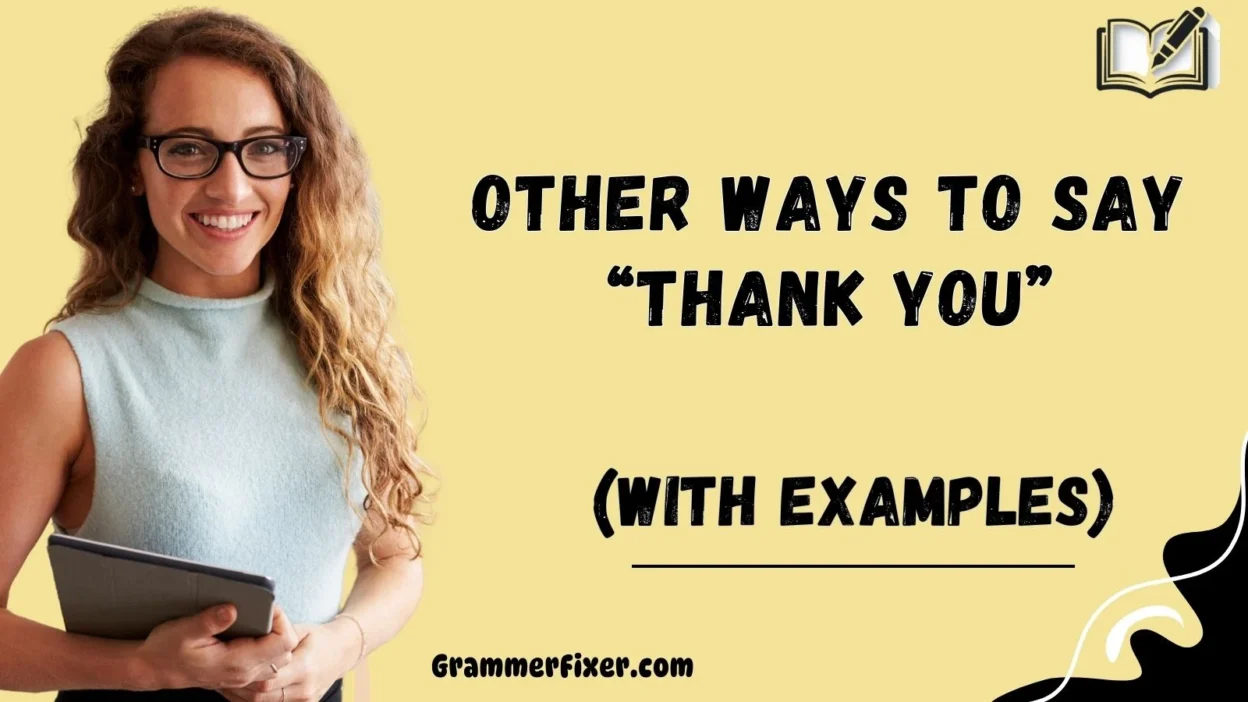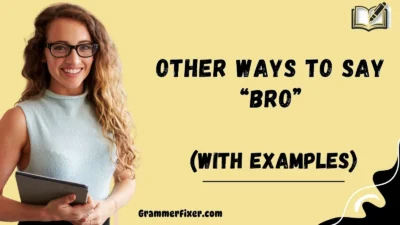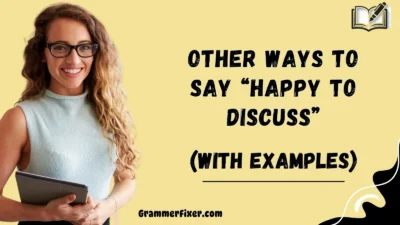Finding the right words to express gratitude can make a world of difference. Whether it’s a simple favor, a thoughtful gift, or someone’s time and support, the way we say “thank you” shapes how our appreciation is received. Using alternative expressions of gratitude can make your message more personal, warm, and meaningful—showing not just politeness but genuine care.
Below, we’ll explore 30 other ways to say “thank you”, complete with meanings, explanations, examples, and guidance on when to use each phrase. These alternatives can help you express heartfelt appreciation in professional, casual, and personal settings.
What Does “Thank You” Mean?
At its core, “thank you” is a verbal or written expression of gratitude. It acknowledges someone’s kindness, effort, or contribution, fostering goodwill and strengthening relationships.
When to Use “Thank You”?
You can use “thank you” in countless moments:
- After receiving a gift
- When someone helps you
- Following an interview or meeting
- In emails, texts, or letters
- During formal occasions like weddings or graduations
- In casual everyday interactions with friends, family, or colleagues
Is It Professional/Polite to Say “Thank You”?
Yes, “thank you” is both professional and polite. It works across cultures, in emails, conversations, and even formal applications. However, varying your words shows thoughtfulness and avoids sounding repetitive or robotic.
Pros or Cons of Saying “Thank You”
Pros:
- Universally understood
- Always polite and respectful
- Works in any setting
Cons:
- Can feel overused or generic
- Lacks personalization in repeated use
- Sometimes too simple for significant gestures
1. Thanks a Ton
Meaning: A casual, enthusiastic way of expressing deep gratitude.
Explanation: This phrase adds extra emphasis, showing that the help or act meant a lot.
Scenario Example: “Thanks a ton for covering my shift last weekend—I owe you one!”
Best Use: Informal settings with friends, colleagues, or casual texts.
Worst Use: Avoid in highly formal communication, such as job applications.
Tone: Warm, informal, and friendly.
2. Many Thanks
Meaning: A polite but slightly formal alternative.
Explanation: A short, clear phrase often used in emails or written notes.
Scenario Example: “Many thanks for your prompt response to my proposal.”
Best Use: Professional communication, polite emails, letters.
Worst Use: Might feel stiff in casual chats with close friends.
Tone: Respectful, polished, semi-formal.
3. Much Obliged
Meaning: An old-fashioned but still charming way to say you feel indebted.
Explanation: Expresses humility and politeness, often with a touch of formality.
Scenario Example: “Much obliged for your guidance during the onboarding process.”
Best Use: Formal, academic, or respectful interactions.
Worst Use: Avoid in casual or playful conversations—it can sound outdated.
Tone: Courteous, formal, respectful.
4. Cheers
Meaning: A lighthearted, casual thank-you.
Explanation: Common in British English, “cheers” conveys both gratitude and goodwill.
Scenario Example: “Cheers for helping me move my stuff into the new apartment!”
Best Use: Informal messages, casual workplace culture, friendly texts.
Worst Use: Not suitable in serious or formal communications.
Tone: Playful, friendly, easygoing.
5. I Owe You One
Meaning: A casual way to acknowledge gratitude while promising a return favor.
Explanation: Shows appreciation and reciprocity.
Scenario Example: “I owe you one for lending me your notes before the exam.”
Best Use: Among friends, colleagues, or casual interactions.
Worst Use: Avoid in professional emails or formal letters.
Tone: Casual, reciprocal, lighthearted.
6. Thanks a Million
Meaning: Exaggerated way to emphasize gratitude.
Explanation: Hyperbolic but warm, showing enthusiasm.
Scenario Example: “Thanks a million for stepping in when things got stressful.”
Best Use: Friendly notes, warm workplace culture, casual chats.
Worst Use: Too informal for highly professional or academic contexts.
Tone: Energetic, heartfelt, casual.
7. I’m Truly Grateful
Meaning: A sincere and thoughtful phrase expressing deep appreciation.
Explanation: Stronger than a simple “thank you,” highlighting sincerity.
Scenario Example: “I’m truly grateful for your mentorship throughout my career journey.”
Best Use: Professional settings, heartfelt personal messages.
Worst Use: Avoid for small or casual gestures—it may feel overly intense.
Tone: Genuine, respectful, heartfelt.
8. I Really Appreciate It
Meaning: A straightforward yet warm way to recognize someone’s effort.
Explanation: Makes gratitude more personal by focusing on “appreciation.”
Scenario Example: “I really appreciate it when you share your insights in our meetings.”
Best Use: Everyday conversations, professional interactions.
Worst Use: Avoid overuse—it can lose impact if repeated constantly.
Tone: Warm, conversational, professional-friendly.
9. Thanks Kindly
Meaning: A polite and slightly old-fashioned alternative.
Explanation: Adds charm and gentleness to gratitude.
Scenario Example: “Thanks kindly for holding the door.”
Best Use: Polite conversations, lighthearted notes, casual exchanges.
Worst Use: Rare in formal professional writing.
Tone: Courteous, soft, friendly.
10. Much Appreciated
Meaning: A simple phrase acknowledging gratitude clearly.
Explanation: Useful when you want to keep your message short but warm.
Scenario Example: “Your feedback was much appreciated during my presentation.”
Best Use: Emails, quick texts, business interactions.
Worst Use: Too brief for highly emotional situations.
Tone: Concise, professional, polite.
11. I Can’t Thank You Enough
Meaning: A strong way to express that words feel inadequate for the gratitude you feel.
Explanation: Implies the person’s help or kindness was so impactful that a simple “thank you” isn’t enough.
Scenario Example: “I can’t thank you enough for being there during that difficult time.”
Best Use: Emotional situations, personal notes, heartfelt messages.
Worst Use: Avoid for small favors (like borrowing a pen) — it can sound exaggerated.
Tone: Deep, emotional, sincere.
12. Thanks So Much
Meaning: A warm, casual expression of gratitude.
Explanation: Adds emphasis to “thanks” without sounding too formal.
Scenario Example: “Thanks so much for helping me prepare for the presentation.”
Best Use: Everyday conversations, work chats, texts.
Worst Use: Can feel repetitive if overused.
Tone: Friendly, warm, conversational.
13. Warmest Thanks
Meaning: A heartfelt, gentle way to express gratitude.
Explanation: Adds emotional warmth, making the thank-you feel more personal.
Scenario Example: “Warmest thanks for your thoughtful gift—it truly brightened my day.”
Best Use: Personal letters, cards, or messages to friends and family.
Worst Use: Too sentimental for formal workplace settings.
Tone: Heartfelt, warm, affectionate.
14. Deepest Gratitude
Meaning: A very formal and respectful expression of profound thanks.
Explanation: Ideal for situations where you want to emphasize seriousness and humility.
Scenario Example: “Please accept my deepest gratitude for your unwavering support throughout the project.”
Best Use: Academic, professional, or serious personal contexts.
Worst Use: Not suitable for casual or lighthearted exchanges.
Tone: Formal, respectful, sincere.
15. Forever Grateful
Meaning: Conveys long-lasting and permanent appreciation.
Explanation: Suggests the person’s help or kindness had a lasting impact.
Scenario Example: “I’ll be forever grateful for the opportunity you gave me in this role.”
Best Use: Emotional personal notes, mentorship acknowledgments, heartfelt messages.
Worst Use: Avoid in casual situations — it may sound dramatic.
Tone: Emotional, genuine, lasting.
16. Thank You Kindly
Meaning: A softer, polite variation of “thank you.”
Explanation: Carries a courteous and friendly tone, sometimes old-fashioned.
Scenario Example: “Thank you kindly for taking the time to review my application.”
Best Use: Emails, formal but friendly exchanges, polite conversations.
Worst Use: Too gentle for highly professional or corporate contexts.
Tone: Polite, warm, approachable.
17. Thanks a Bunch
Meaning: Informal and playful way of expressing gratitude.
Explanation: A cheerful, casual phrase often used in friendly conversations.
Scenario Example: “Thanks a bunch for grabbing coffee for me this morning!”
Best Use: Informal chats, texts with friends, lighthearted interactions.
Worst Use: Avoid in formal or academic communications.
Tone: Playful, casual, cheery.
18. I Appreciate Your Help
Meaning: Clear acknowledgment of someone’s effort or support.
Explanation: Highlights not just the thanks but the specific act of help.
Scenario Example: “I appreciate your help with coordinating the project deadline.”
Best Use: Workplace communication, polite exchanges, constructive feedback.
Worst Use: Too plain for highly emotional situations.
Tone: Professional, respectful, straightforward.
19. Thanks for Everything
Meaning: Broad, heartfelt gratitude that covers multiple acts of kindness.
Explanation: Recognizes someone’s overall presence and support, not just one action.
Scenario Example: “Thanks for everything you’ve done to help us get settled in the new city.”
Best Use: Family, close friends, long-term colleagues.
Worst Use: Can feel vague in professional or specific contexts.
Tone: Warm, appreciative, holistic.
20. Thanks for Your Support
Meaning: A polite and specific way to thank someone for standing by you.
Explanation: Acknowledges encouragement, assistance, or backing in a situation.
Scenario Example: “Thanks for your support during the conference preparation.”
Best Use: Professional and personal settings alike, especially in collaborative work.
Worst Use: Too generic if you want to highlight a very specific action.
Tone: Respectful, appreciative, professional-friendly.
21. With Gratitude
Meaning: A formal and polished phrase often used in closing notes or letters.
Explanation: It conveys humility and respect, making it suitable for serious or professional contexts.
Scenario Example: “With gratitude, I acknowledge your guidance throughout this project.”
Best Use: Professional emails, formal letters, academic writing.
Worst Use: Too formal for everyday chats with friends.
Tone: Respectful, polished, formal.
22. Many Thanks in Advance
Meaning: Expresses appreciation before the favor or action is completed.
Explanation: Polite way of acknowledging expected help, often in requests.
Scenario Example: “Many thanks in advance for reviewing my proposal.”
Best Use: Professional emails, polite requests, workplace communication.
Worst Use: Avoid if it feels presumptive in sensitive situations.
Tone: Courteous, anticipatory, professional.
23. Thanks Again
Meaning: A polite way to repeat gratitude for emphasis.
Explanation: Often used in follow-ups to reinforce appreciation.
Scenario Example: “Thanks again for meeting with me earlier—I really enjoyed our discussion.”
Best Use: Emails, follow-up notes, casual chats.
Worst Use: May sound repetitive if used too often in one exchange.
Tone: Friendly, warm, polite.
24. Thanks for the Kind Words
Meaning: A specific way to thank someone for their compliments or encouragement.
Explanation: Acknowledges verbal or written appreciation.
Scenario Example: “Thanks for the kind words about my presentation—it means a lot.”
Best Use: Personal and professional acknowledgment of compliments.
Worst Use: Not suitable for actions or favors—it’s specific to words.
Tone: Warm, gracious, appreciative.
25. Thank You Ever So Much
Meaning: A sweet, slightly old-fashioned phrase with extra warmth.
Explanation: Adds charm and a touch of sincerity.
Scenario Example: “Thank you ever so much for helping me prepare for the wedding.”
Best Use: Cards, personal notes, heartfelt moments.
Worst Use: Too sentimental for corporate settings.
Tone: Gentle, affectionate, sincere.
26. Thanks for Being There
Meaning: Gratitude for emotional support or presence.
Explanation: Goes beyond a simple action—acknowledges someone’s reliability and care.
Scenario Example: “Thanks for being there when I needed someone to talk to.”
Best Use: Personal relationships, friendships, family.
Worst Use: Doesn’t apply well in professional contexts.
Tone: Emotional, heartfelt, personal.
27. Endless Thanks
Meaning: Hyperbolic way to emphasize ongoing gratitude.
Explanation: Suggests that the gratitude feels limitless due to the importance of the act.
Scenario Example: “Endless thanks for your dedication to this project—it made all the difference.”
Best Use: Special occasions, heartfelt notes, significant gestures.
Worst Use: Avoid for small or everyday favors—it feels too grand.
Tone: Strong, expressive, emotional.
28. Thank You from the Bottom of My Heart
Meaning: Deeply emotional and heartfelt expression of thanks.
Explanation: Indicates that the gratitude is personal and genuine.
Scenario Example: “Thank you from the bottom of my heart for supporting me through this journey.”
Best Use: Emotional letters, personal notes, family, close friends.
Worst Use: Overly sentimental for professional use.
Tone: Emotional, genuine, heartfelt.
29. Thanks So Very Much
Meaning: A slightly more formal variation of “thanks so much.”
Explanation: Adds emphasis and respect, making it sound more thoughtful.
Scenario Example: “Thanks so very much for your valuable feedback on my application.”
Best Use: Semi-formal notes, professional emails, polite texts.
Worst Use: Can sound exaggerated in casual conversations.
Tone: Respectful, thoughtful, slightly formal.
30. Thank You Sincerely
Meaning: A respectful and polished way to close a message.
Explanation: Suggests genuine and honest appreciation, often used in writing.
Scenario Example: “Thank you sincerely for considering my application.”
Best Use: Professional letters, applications, academic correspondence.
Worst Use: Too formal for everyday, casual interactions.
Tone: Formal, polished, genuine.
Conclusion
Finding other ways to say “thank you” helps us communicate with more depth, warmth, and authenticity. While the phrase itself is always polite and appropriate, varying your expression adds a personal touch that makes your gratitude more memorable and impactful.



